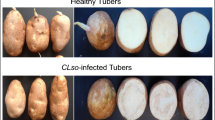Abstract
cDNAs encoding two Bowman-Birk proteinase inhibitors were isolated from the leaves of alfalfa (Medicago sativa). The cDNAs are derived from a small gene family (3 to 10 genes) encoding alfalfa trypsin inhibitors (ATIs). Each cDNA clone encoded a mature ATI that was part of a larger, putative preprotein. ATI mRNAs are continuously expressed in flower parts, but are mechanically wound-inducible in the stems and leaves. ATI mRNA is shown to be continuously present in roots of soil-grown plants, but its presence is primarily in response to microorganisms present in the soil. Additionally, while mechanical wounding of the alfalfa roots induced ATI mRNA synthesis both in the roots and in the leaves, microbial infection of the roots triggered ATI mRNA synthesis in the roots but not in the leaves. These results suggest that both local and systemic signalling pathways for proteinase inhibitor synthesis are present in alfalfa plants.
Similar content being viewed by others
References
Ryan CA: Protease inhibitors in plants: genes for improving defenses against insects and pathogens. Annu Rev Phytopath 28: 425–449 (1990).
Ryan CA, An G: Molecular biology of wound-inducible proteinase inhibitors in plants. Plant Cell Environ 11: 345–349 (1988).
Pena-Cortes H, Wilmitzer L, Sanchez-Serrano JJ: Abscisic acid mediates wound induction but not developmental-specific expression of the proteinase inhibitor II gene family. Plant Cell 3: 963–972 (1991).
Atkinson AH, Heath RL, Simpson RJ, Clarke AE, Anderson MA: Proteinase inhibitors in Nicotiana alata stigmas are derived from a precursor protein which is processed into five homologous inhibitors. Plant Cell 5: 203–213 (1993).
Pautot V, Holzer FM, Walling LL: Differential expression of tomato proteinase inhibitor I and II genes during bacterial pathogen invasion and wounding. Mol Plant Microb Inter 4: 284–292 (1991).
Ryan CA: The search for the proteinase inhibitor-inducing factor, PIIF. In: Schilperoort R, Dure L (eds) 10 Years of Plant Molecular Biology, pp. 123–133, Kluwer Academic Publishers, Dordrecht (1992).
Farmer EE, Ryan CA: Octadecanoid-derived signal in plants. Trends Biochem Sci 2: 236–241 (1992).
Brown WE, Ryan CA: Isolation and characterization of a wound-induced trypsin inhibitor from alfalfa leaves. Biochemistry 23: 3418–3422 (1984).
Brown WE, Takio K, Titani K, Ryan CA: Wound-induced trypsin inhibitor in alfalfa leaves: identity as a member of the Bowman-Birk inhibitor family. Biochemistry 24: 2105–2108 (1985).
Ryan CA: Proteinase Inhibitors. In: Stumpf PK, Con EE (eds) The Biochemistry of Plants: A Comprehensive Treatise, vol. 6. Proteins and Nucleic Acids, pp. 351–370. Academic Press, New York (1981).
Rohrmeier T, Lehle L: WIJP 1, a wound-inducible gene from maize with homology to Bowman-Birk proteinase inhibitors. Plant Mol Biol 22: 783–792 (1993).
Gubler U, Hoffmann BJ: A simple and very efficient method for generating cDNA libraties. Gene 25: 263–269 (1983).
Sanger F, Nicklen S, Coulson AR: DNA sequencing with chain-terminating inhibitors. Proc Natl Acad Sci USA 74: 5463–5465 (1977).
Rogers SO, Bendich AJ: Extraction of DNA in plant tissues. In: Gelvin SB, Schilperoort RA, Verma DPS (es) Plant Molecular Biology Manual, pp. A6: 1–10. Kluwer Academic Publishers, Dordrecht (1988).
Maniatis T, Fritsch EF, Sambrook J: Molecular Cloning; A Laboratory Manual, pp. 202–203. Cold Spring Harbor Laboratory Press, Cold Spring Harbor, NY (1982).
Somerville JE, Kahn ML: Cloning of the glutamine synthetase I gene from Rhizobium meliloti. J Bact 156: 168–176 (1983).
Walker-Simmons M, Ryan CA: Immunological identification of proteinase inhibitors I and II in isolated tomato leaf vacuoles. Plant Physiol 60: 61–63 (1977).
Hilder VA, Barker RF, Samour RA, Gatehouse AMR, Gatehouse JA, Boulter D: Protein and cDNA sequences of Bowman-Birk protease inhibitors from the cowpea (Vigna unguiculata Walp). Plant Mol Biol 13: 701–710 (1989).
Hahn MG, Darvill AG, Albersheim P: Host-pathogen interactionst. XIX. The endogenous elicitor, a fragment of a plant cell wall polysaccharide that elicits phytoalexin accumulation in soybeans. Plant Physiol 68: 1161–1169 (1984).
Bruce RJ, West CA: Elicitation of casbene synthetase activity in castor bean. The role of pectic fragments of the plant cell wall in elicitation by a fungal endopolygalacturonase. Plant Physiol 69: 1181–1188 (1982).
Bishop P, Pearce G, Bryant JE, Ryan CA: Isolation and characterization of the proteinase inhibitor inducing factor from tomato leaves: identity and activity of poly- and oligogalacturonide fragments. J Biol Chem 259: 13172–13177 (1984).
Farmer EE, Ryan CA: Octadecanoid precursors of jasmonic acid activate the synthesis of wound-inducible proteinase inhibitors. Plant Cell 4: 129–134.
Author information
Authors and Affiliations
Rights and permissions
About this article
Cite this article
McGurl, B., Mukherjee, S., Kahn, M. et al. Characterization of two proteinase inhibitor (ATI) cDNAs from alfalfa leaves (Medicago sativa var. Vernema): the expression of ATI genes in response to wounding and soil microorganisms. Plant Mol Biol 27, 995–1001 (1995). https://doi.org/10.1007/BF00037026
Accepted:
Issue Date:
DOI: https://doi.org/10.1007/BF00037026




